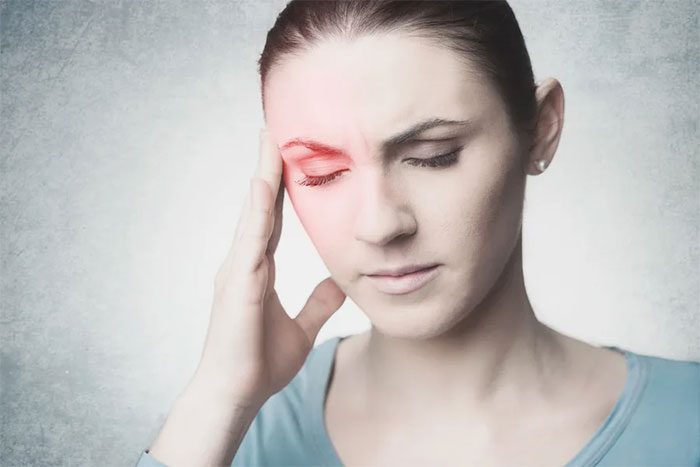The eye socket is a pyramidal cavity structure with its apex directed backward and the base expanded forward, formed by the skull and facial bones. Within the eye socket, there are soft tissues including the optic nerve, blood vessels, extraocular muscles, and the eyeball. There are many causes that can lead to pain in the eye socket.
Causes of Eye Socket Pain
Below are some common causes often encountered:
1. Eye Strain
This is a form of mild increased pressure in the eyes that can cause eye socket pain. This condition is common among individuals who use computers and other electronic devices in low-light environments. Although this is not a dangerous medical condition, prolonged eye strain can lead to dryness, blurred vision, or pressure behind the eyes.
Eye Strain Relief Exercises
Warm-ups are eye exercises that help relax the eye muscles and improve circulation in the small blood vessels of the eyes. This way, the eyes become less strained and are provided with enough nutrients and oxygen for sustained activity. Here’s how to perform it:
Wash your hands thoroughly, then rub the palms together vigorously until they feel warm. After that, close your eyes and quickly place the warm palms over your eyes until the heat dissipates. You can repeat this motion 2-3 times per session and practice several times throughout the day.
In addition to the above exercise, other exercises such as blinking, zooming in and out with your gaze, changing your line of sight, drawing the number eight with your eyes, shifting the focus of your vision, and practicing near and far vision can also help reduce eye strain.
2. Sinusitis
It is not surprising that sinusitis can cause pain in the eye sockets during flare-ups. The sinuses are made up of spongy cartilage structures within the bones. The lightness of the skull and facial bones is due to the many sinus cavities, including the frontal, maxillary, and occipital sinuses.
Sinusitis occurs when mucus buildup obstructs airflow, causing fluid to not drain properly, leading to blocked sinus openings, creating an environment for bacteria and fungi to grow, or due to other factors such as chemical irritants or allergic rhinitis.
Sinus pain occurs in various regions, including the maxillary, frontal, anterior ethmoidal, and posterior ethmoidal sinuses. Among these, anterior ethmoidal sinusitis can cause pain in the eye sockets, especially when leaning forward.

It is not surprising that sinusitis can cause pain in the eye sockets during flare-ups. (Photo: ST).
3. Eye Diseases Causing Eye Socket Pain
Pain in the eye sockets can also result from various eye diseases such as:
| Disease | Common Symptoms | Severe Complications | Age Group |
|---|---|---|---|
| Orbital Inflammation | – Swelling and redness of the eyelids and surrounding soft tissues – Conjunctival congestion and edema – Limited eye movement – Pain during eye movement – Reduced vision – Protrusion of the eyeball due to swelling of the orbital tissues | – Pain – Protrusion of the eyeball – Ocular motility paralysis – Conjunctival edema | All ages, common in children under 7 years old |
| Orbital Tumor | – Most commonly causes protrusion of the eyeball – Pain in the eye socket when the optic nerve is compressed by the growing tumor – Significant vision loss – Double vision, red eyes, conjunctival hemorrhage, eyelid drooping, dilated pupils, eyelid swelling, increased susceptibility to infections,… | Orbital tumors can be benign or malignant | All ages |
| Acute Angle-Closure Glaucoma | – Marked vision impairment, blurry vision, seeing bright objects with rainbow halos – Severe and intense eye socket pain accompanied by headaches – Redness and pain in the eyes, swollen eyelids, tearing – Nausea and vomiting | Optic nerve damage leading to blindness or irreversible vision loss | – Females are at higher risk than males, especially during menopause – The older you are, the higher the risk, especially over 70 years old |
| Optic Neuritis | – Usually affects the vision of one eye – Moderate to severe eye pain, increasing with eye movement or dull pain behind the eye – Vision loss in one eye, loss of visual field, and color vision loss – Seeing flashing lights like a lamp, increasing with eye movement | – Permanent optic nerve damage – Vision loss, color confusion, or permanent vision loss – Side effects of steroid treatments making you more susceptible to infections, weight gain, osteoporosis, or other disorders | Common in individuals aged 20-40 years |
| Corneal Inflammation | – Dull or sharp eye pain, burning sensation in the eyes – Sensation of foreign body in the eye, eye strain – Light sensitivity, glare, blurry vision, increased tearing along with swollen eyelids or difficulty opening the eyes due to excessive discharge – Opacity of the cornea, with white spots in the center | – Chronic corneal inflammation – Chronic or recurrent viral infections in the cornea – Corneal ulcers, corneal perforation. – Suppurative endophthalmitis – Corneal scarring – Temporary or permanent vision loss – Total vision loss | All ages, males are at higher risk than females |
| Orbital Trauma (Direct or Indirect) | – Hemorrhage in the eye – Bruising or tearing of tissues in the orbit causing deformities – Foreign bodies in the orbit causing corneal abrasions,… – Orbital fracture (the eye appears to bulge or sink into the orbit, black eye, double vision or blurriness, numbness around the injured orbit, flatter cheeks, and pain when opening the mouth) | Depends on the severity of the injury and the level of detection + patient response to treatment | All ages |
4. Graves’ Disease
Due to hyperactivity of the thyroid gland, Graves’ disease causes swelling of the tissues, muscles, and fat in the eye socket, leading to the eyeball protruding from the orbit and resulting in related issues such as inability to move the eyeball. Other common symptoms associated with the eyes in Graves’ disease include:
- Discomfort in the eyes, dryness, and increased tearing
- Protruding eyeballs
- Double vision
- Increased sensitivity to light
- Possible eye ulcers, swollen eyeballs, or inability to move the eyeballs
- Vision loss.

Due to hyperactivity of the thyroid gland, Graves’ disease causes swelling of the tissues, muscles, and fat in the eye socket. (Photo: ST).
5. Tooth Pain
Tooth pain, especially due to infection, can cause sharp pain and a feeling of pressure that radiates to surrounding areas of the face due to affected nerves, particularly the trigeminal nerve. In addition to pain in the eye sockets, vision in the affected eye socket may worsen if the tooth pain intensifies without treatment.
6. When to See a Doctor?
Anyone noticing abnormal signs in the eye socket or eyes, such as vision loss, bulging eyes, fever, frequent headaches, swollen eyes, and facial swelling, should see a doctor as soon as possible. Sometimes, eye socket pain may not be a serious medical issue, but its presence can indicate a risk of a more acute condition.
Depending on the cause of the eye socket pain, the doctor may prescribe appropriate treatments such as anti-inflammatory medications, pain relievers, antibiotics, or antihistamines (in case of eye allergies). Never self-medicate without a doctor’s prescription. Avoid rubbing your eyes forcefully as it may cause more serious damage.
Additionally, individuals with eye socket pain should rest their eyes, limit exposure to sunlight, apply cold compresses to reduce strain and pain, or gently massage the area to improve blood circulation to the eyes.


















































